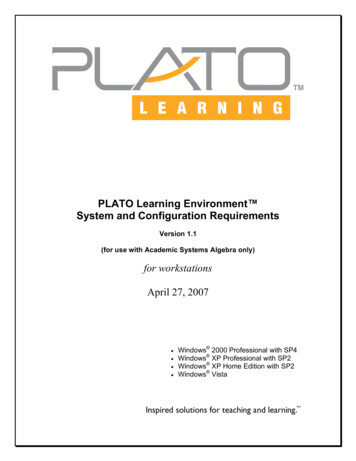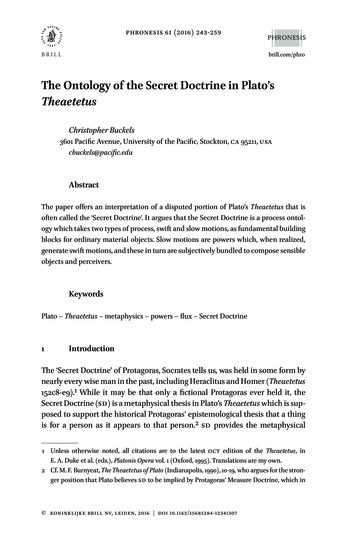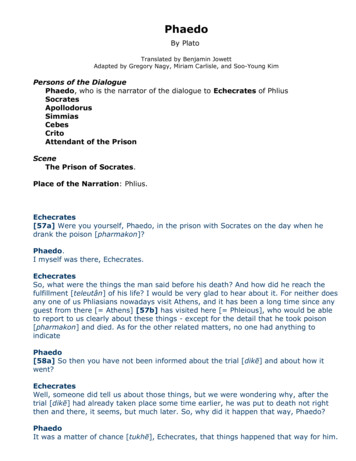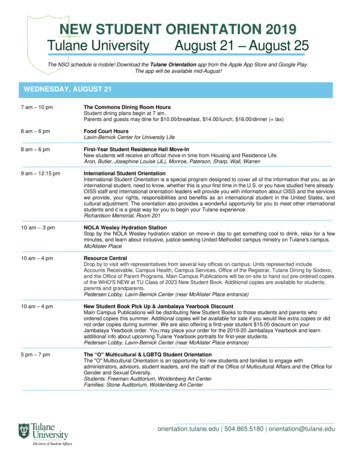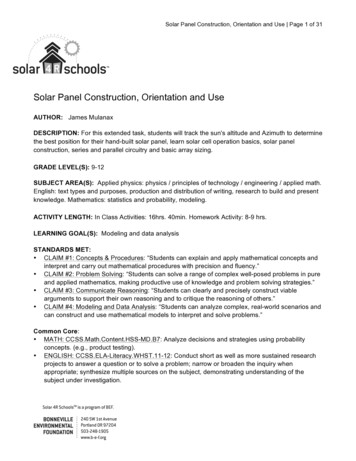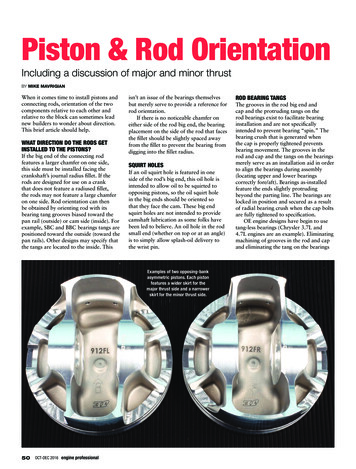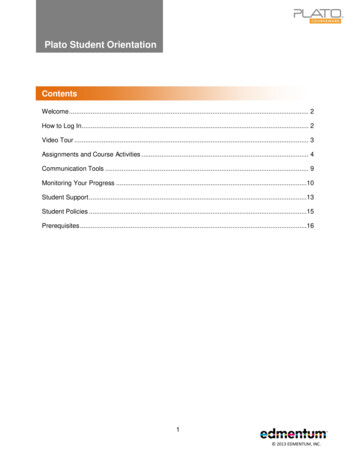
Transcription
Plato Student OrientationContentsWelcome . 2How to Log In . 2Video Tour . 3Assignments and Course Activities . 4Communication Tools . 9Monitoring Your Progress .10Student Support .13Student Policies .15Prerequisites .161 2013 EDMENTUM, INC.
WelcomeWelcome to Plato Learning! We are excited to help you meet your educational needs andbecome a star student. This Student Orientation Toolkit will guide you to the resources andinformation that you'll need to begin learning with Plato Courses.This toolkit will help you access and use the features of the Plato Learning Environment(PLE). You’ll see how to log in to PLE and learn how to complete different onlineassignments, including drop-box activities, assessments, and open-ended discussions withother students.You will also have access to the PLE Student Orientation Tutorial. This short video willshow you all the features that you can access or use in PLE.Your responsibilities Stay on track with your assigned courses. Complete assignments on time and to the best of your abilities. Contact your teacher whenever you have a question or a problem.How to Log InYou should receive your log-in information before starting Plato courses. Please contactyour instructor if you have not received it.Visit the Plato Learning Environment site to open the Plato courses log-in screen.If you ever forget your password, the log-in screen provides a link to access at any time toreset your password.2
Video TourThe Student Orientation Tutorial covers the features of the Plato Learning Environment indetail. After viewing this tutorial, read through the rest of this document for help on gettingstarted in the PLE environment.3
Assignments and Course ActivitiesTutorialsTutorials are modules with direct instruction and practice interactions. They include engagingactivities, such as videos, animations, interactive timelines, and hotspot graphics. Tutorialsalso have practice interactions such as drag-and-drops, ordered problem solvers, multiplechoice questions, and fill-in-the blank questions that help you to check your progress atmastering new concepts. Some tutorials also include Web links to informational sites,games, and videos, which are designed to broaden your access to information on the topic.Mastery TestsA mastery test is included in each module. After completing the tutorial, you will take this briefassessment to show you and your instructor whether you have mastered the objectives in thelesson. Each test will explain the requirements for mastery before you begin answeringquestions. The results of these tests are reported as either mastered or not mastered.If you do not master a test on your first attempt, contact your instructor to unlock the test foranother attempt. You will need to complete the tutorial again in order to retake the masterytest.4
AssessmentsEvery Pretest, Posttest, and End-of-Semester Test contains a unique set of questions.Assessments may include these types of questions: Multiple ChoiceEssayGrid ResponseClick a test link to open an assessment. Keep in mind that once you have attempted all thequestions, the test is locked and you will not be able to open that assessment again.This test screen consists of following:Multiple Choice – A question is displayed at the top of the screen. If a question has apassage, the passage appears in a separate window. All possible answer options are listedand labeled with a letter. You will be asked to click the correct answer.Essay Questions – A question is displayed and a blank text area is provided for you to typein your answer. Click the Save button to save your choices.Grid Response – A grid is displayed with a text box at the top. When you select an option,the option is displayed in the text box. The Clear button clears the text in the box.5
The Assessment Screen includes the following information:Total Number of Questions – The total number of questions will be listed at the top of thescreen, along with what question you are currently viewing.Submit Answer – Click the Submit Answer to go to the next question in the assessment.Save & Exit – You can save your test and continue at a later time. To save, click OKwhen prompted. It will list how many questions you have answered, questions leftunanswered, and time spent on the test.Grade Test – click the Grade Test button to submit your test responses for grading. You willbe informed whether all questions have been answered before completing this process.6
ExemptionsYour instructor can choose to exempt, or excuse, you from a unit in a PLATO course. Youmay also be exempted from a unit or module after completing a unit pretest. The pretestquestions cover the objectives in each module of a unit. Your exemption status is based onwhich questions you answered correctly.See the example below of a student’s exemption status. It shows those modules that the studentis not required to take. Even if you are exempted from taking a unit or module, you can stillaccess the material at any time.Drop BoxA digital drop box activity allows you to upload digital files related to an assignment for reviewand grading by your instructor.7
DiscussionsDiscussion activities ask complex, open-ended questions. They encourage you to reflect onconcepts, articulate your thoughts, and respond to the views of others. You’ll need to thinkcritically to answer these questions.Discussion activities can be section discussions or threaded discussions. Sectiondiscussions are non-graded discussions. You can reply to an open-ended question orrespond to other students’ thoughts. To access section discussions, click the Discussionstab on your Home Page.Threaded discussions, on the other hand, are graded. Your instructor will grade you on thereplies you submit to a discussion topic. These discussions are located under yourAssignments page. Click on the discussion link to read, reply, and submit your response.8
Communication ToolsMessagesClick the Messages tab on the Home Page to view your online messages. TheMessages page holds all the online communication between you and your instructor.This page also displays notifications sent by your instructor.AnnouncementsCheck the Home page for announcements from your instructors or program administrators.You can also view the status of your assignments on the Home Page.9
Monitoring Your ProgressYou can keep track of your progress on a course by using three reports, the Learner PortfolioReport, the Graphic Learner Progress Report, and the View Progress report. The LearnerPortfolio Report can be accessed directly from your Home Page. The other two are found byclicking the Assignments tab on the Home Page. Under the Reports column, you can seeboth these reports.View Progress ReportThe View Progress report allows you to monitor your progress on an assignment. When youclick the View Progress link, the screen displays the Learner Progress Report for the selectedassignment.Printable View – Clicking this button allows you to print the report.Title – Displays the assignment name followed by the unit, modules, and activities withinthe modules. You can navigate through the assignment by clicking the and – icons toexpand and contract sections of the report.Completion – Displays the legend icon corresponding to the progress made on theassignment: not started, in progress, or completed.Exemption – Displays and icon if you are exempted from taking that assignment.Mastery – Displays an icon that indicates whether you have mastered a module’s objectives.Completion Date – The date that mastery of a module is completed.# of Tries – Displays the number of attempts made to achieve mastery.First Use Date – The date when you first launched the activity.10
Last Use Date – The last date when you launched the activity.Time on Task – Displays the time in hours and minutes that you have spent on an activity.Score – Displays a score in terms of percentage where applicable.Graphic Progress ReportThis report summarizes your overall progress on a course. The report does not break down yourprogress by unit.Assignment Name – Displays the assignment name.Total Modules – Displays the total number of modules in the assignment.Modules Mastered – Displays the number of modules you have mastered.Percent of Modules Mastered – Displays the progress on modules mastered as a percentage.Total Time on Task – The total amount of time you have spent on the assignment.Average Module Mastery Time – The average time it took you to master a module.Progress Bar – A visual representation of the percentage of modules mastered.11
Learner Portfolio ReportThis report provides information about all assignments and assessments you have everperformed within PLE.Class – Displays the class in which the assignment was for.Instructor – the name of the instructor for the specific class.Assignment – Displays the assignment nameCompletions Status – Provides the status of the assignmentStart Date – The date in which the assigned was assigned to you.Completion Date – The expected complete date set by the instructor.Modules Mastered – Displays the number of modules you have mastered.Total – Displays the total number of modules in the assignment.% Modules Completed – A visual representation along with the percentage of modulesmastered.Total Tme on Task - The total amount of time you have spent on the assignment.12
Student SupportAs you progress through your course, there is support with you the entire way. Tutorials includetools to help you throughout the lesson. Some of these tools are subject-specific. Widelyavailable tools include: Reader SupportNotebookCalculatorScientific CalculatorReader SupportThe reader support feature is available at the top left corner of the screen.Clicking the Reader Support button gives you the option of listening to, translating, ordefining any text you enter into the text area of the tool. You can type directly into this fieldor just highlight directly from the passage and click the respective button.You can choose from four different voices to read the text. The text can be translated intoeight languages: Spanish, French, German, Chinese-simplified, Chinese-traditional,Japanese, Portugal, and Russian. The Define option provides definitions in English and inSpanish13
HelpWhen problems or questions arise, you should always contact your instructor for guidance.Your second option is to access the 24/7 self-service support link. Clicking the help button willtake you to the Edmentum Support Center, which contains general information and answers tomany common questions.Technical ReadinessPop-up blockers must be disabled or configured properly in order to run PLATO coursewaresuccessfully. Pop-up blockers or stoppers are used to prevent additional windows, typicallyadvertisements, from opening within the Web browser.Pop-up blocking software disables JavaScript pop-up ads, but it also disables legitimate sitefunctionality using JavaScript. The procedures to disable or configure pop-up blockers vary,depending on the software used.Click here to learn how to turn off pop-up blockers for Plato activities.Your workstation must be configured to run content in Plato products. Use the following Wizardto prepare your workstation for Plato products. The Wizard will also help you resolve commonproblems such as assignments failing to launch.14
Student PoliciesCourse Credit and GradingSemester-based courses are one-half credit. Courses consist of a blend of self-paced andguided instruction that includes tutorials, mastery tests, lesson activities, and other activities thatrequire completion for course credit. Each course has a required final exam, which will beproctored.To earn one-half credit, you must meet two basic requirements: Complete all assigned work, unless exempted by test or excused by your teacher. Earn a combined average of at least 60 percent on course-level assessments (unit ormidterm tests and semester exams.)Teachers will provide you with written information if these requirements will differ for a specificcourse. In addition, teachers will set and share a written grading policy for their class.Student Expectations and ConductYou are required to work consistently and to follow the Course Pacing Guide provided in yoursyllabus. You may complete more than what the pacing suggests and you are encouraged to doso.Except when instructed otherwise, you are expected to complete your work on your own.Copying work from others, plagiarizing content without proper citation, and other forms ofcheating will not be tolerated.You are expected to carry our regular and timely communication with their teachers. You shouldrespond within 24 hours to any emails from your teacher.Finally, you are expected to show respect for students and staff through courteouscommunications and interactions. This includes proper “netiquette” and respect for the privacyof others.EdOptions Academy Student PoliciesEdmentum/EdOptions Academy students refer to the complete EdOptions Academy StudentPolicy Guide for further policy details, especially with regard to the Right to Privacy Policy andthe EdOptions Academy Student Code of Conduct.15
PrerequisitesWe want you to start off on the right foot as you begin your Plato Course! Once you have readthrough this entire document, please make sure you are able to do the following: Successfully set up your workstation.Complete basic operations with word processing software, such as Microsoft Word orGoogle Docs.Understand how to download and upload attachments in emails.Perform online research using search engines and library databases.Communicate effectively with your teachers through email.Participate in discussion boards.Be able to access Edmentum Support should any technical issues arise.Understand netiquette when working with others in an online environment.Please contact your teacher, review the Student Orientation video, or access the EdmentumSupport Center, if you need help with any of the above requirements.16
Welcome to Plato Learning! We are excited to help you meet your educational needs and become a star student. This Student Orientation Toolkit will guide you to the resources and information that you'll need to begin learning with Plato Courses. This toolkit will help you access and use the features of the Plato Learning Environment (PLE).File Size: 1MB

